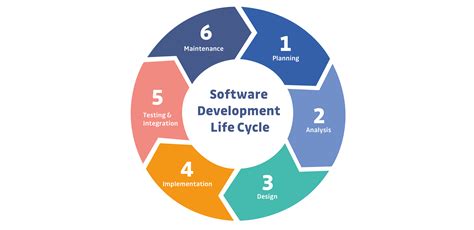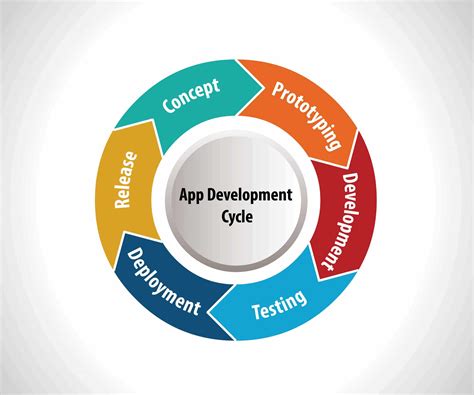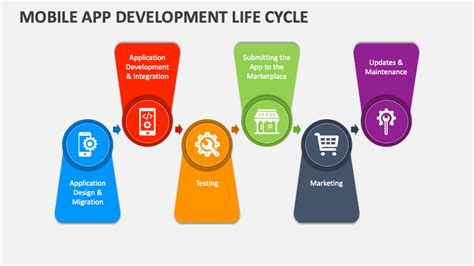Mobile App Development Lifecycle

The mobile app development lifecycle is a complex, multidisciplinary process that encompasses a wide range of activities, from initial conceptualization to post-launch maintenance and updates. With the rapid evolution of mobile technologies and the ever-changing needs of users, understanding the lifecycle of mobile app development is crucial for businesses and developers seeking to create successful, user-centric applications. In this article, we will delve into the various stages of the mobile app development lifecycle, highlighting key considerations, best practices, and the importance of adopting a user-driven approach.
Key Points
- Discovery and planning are critical initial stages that define the app's purpose, target audience, and technical requirements.
- Designing a user-friendly interface and user experience (UI/UX) is essential for engaging users and ensuring app adoption.
- Development involves the actual coding of the app, with choices between native, hybrid, and cross-platform approaches.
- Testing and quality assurance (QA) are vital for identifying and fixing bugs, ensuring compatibility, and meeting performance standards.
- Deployment involves releasing the app on app stores, with ongoing maintenance and updates necessary to address user feedback and evolving market trends.
- Monitoring and analysis of user engagement and app performance provide valuable insights for future development and optimization.
Discovery and Planning

The first stage of the mobile app development lifecycle is discovery and planning. This stage is foundational, as it involves defining the app’s purpose, identifying the target audience, and outlining the technical requirements and resources needed for development. Key activities during this phase include market research, competitor analysis, and stakeholder interviews to validate the app idea and understand user needs. Additionally, creating a detailed project plan, including timelines, budgets, and resource allocation, helps ensure the project stays on track and meets its objectives.
Defining Project Scope and Requirements
Defining the project scope and requirements is a critical aspect of the planning phase. This involves specifying the app’s features, functionalities, and the technologies to be used. It’s also essential to establish clear, measurable goals and key performance indicators (KPIs) that will be used to evaluate the app’s success. By doing so, developers can ensure that the app meets the needs of its users and aligns with the overall business strategy.
| Development Phase | Key Activities |
|---|---|
| Discovery and Planning | Market research, competitor analysis, stakeholder interviews, project planning |
| Design | User experience (UX) design, user interface (UI) design, prototyping, usability testing |
| Development | Coding, integration, testing, debugging |
| Testing and QA | Unit testing, integration testing, system testing, user acceptance testing (UAT) |
| Deployment | App store optimization (ASO), app submission, launch planning |
| Maintenance and Updates | Bug fixing, feature updates, performance optimization, security updates |

Design

The design phase of the mobile app development lifecycle focuses on creating a visually appealing and user-friendly interface. This involves both UX and UI design, with the goal of crafting an intuitive and engaging user experience. Designers use various tools and techniques, including wireframing, prototyping, and usability testing, to refine the app’s layout, navigation, and overall look and feel. A well-designed app not only attracts users but also encourages them to continue using the app, thereby enhancing user retention and satisfaction.
User Experience (UX) Design
UX design plays a pivotal role in the mobile app development process. It encompasses understanding user behavior, identifying pain points, and designing solutions that meet user needs. Effective UX design ensures that the app is easy to navigate, efficient in performing tasks, and provides a seamless experience across different devices and platforms. By prioritizing UX, developers can create apps that are not only functional but also enjoyable to use.
Technical specifications, such as screen resolution, device compatibility, and operating system requirements, must also be considered during the design phase. Ensuring that the app is accessible and usable by a wide range of users is crucial for its success. This includes considerations for users with disabilities, adhering to accessibility guidelines such as the Web Content Accessibility Guidelines (WCAG 2.1) for web-based apps or platform-specific accessibility guidelines for native apps.
Development
The development phase is where the app starts to take shape, as designers and developers work together to bring the design concept to life. This stage involves coding the app, integrating various components, testing, and debugging. The choice of development approach—native, hybrid, or cross-platform—depends on the app’s requirements, the development team’s expertise, and the desired user experience. Each approach has its advantages and disadvantages, and selecting the right one is critical for the app’s performance, scalability, and maintainability.
Native vs. Hybrid vs. Cross-Platform Development
Native development involves building apps specifically for a particular mobile platform (e.g., iOS or Android) using the platform’s native tools and programming languages. This approach provides the best performance and access to device hardware but can be more time-consuming and expensive, especially if separate teams are needed for each platform.
Hybrid development, on the other hand, allows developers to build apps using web technologies like HTML, CSS, and JavaScript and then wrap them in a native container to access device hardware. This approach can speed up development and reduce costs but may compromise on performance and native features.
Cross-platform development frameworks, such as React Native and Flutter, offer a middle ground, enabling developers to build apps for multiple platforms from a single codebase while still providing access to native features. The choice between these approaches depends on the project's specific needs, budget, and timelines.
Testing and Quality Assurance (QA)
Testing and QA are vital stages of the mobile app development lifecycle, ensuring that the app meets the required standards of quality, functionality, and user experience. This phase involves various types of testing, including unit testing, integration testing, system testing, and user acceptance testing (UAT), to identify and fix bugs, ensure compatibility across different devices and platforms, and meet performance and security standards.
Importance of Continuous Testing
Continuous testing is an integral part of the agile development methodology, where testing is integrated throughout the development lifecycle rather than being confined to a separate phase. This approach ensures that issues are identified and addressed early, reducing the overall development time and improving the app’s quality and reliability.
What are the primary considerations for mobile app testing?
+Primary considerations include functional testing to ensure the app works as expected, performance testing to evaluate speed and efficiency, security testing to protect user data, and compatibility testing across different devices and platforms.
How does user experience (UX) impact the success of a mobile app?
+A well-designed UX can significantly enhance user engagement, satisfaction, and retention. It involves creating an intuitive, efficient, and enjoyable experience that meets user needs and expectations, ultimately driving the app's success.
What is the role of maintenance and updates in the mobile app development lifecycle?
+Maintenance and updates are crucial for the long-term success of a mobile app. They involve fixing bugs, adding new features, optimizing performance, and ensuring the app remains secure and compatible with evolving technologies and user needs.
Deployment

Once the app has been thoroughly tested and is ready for release, the deployment phase begins. This involves preparing the app for distribution through app stores like Apple App Store for iOS devices and Google Play Store for Android devices. App store optimization (ASO) strategies are applied to improve the app’s visibility and appeal to potential users. A well-planned launch, including marketing campaigns and promotional activities, can significantly impact the app’s initial success and user adoption rates.
App Store Optimization (ASO) Strategies
ASO is critical for increasing an app’s visibility in crowded app stores. Effective strategies include selecting the right keywords for the app’s title, description, and tags; creating eye-catching icons and screenshots; and encouraging users to leave reviews and ratings. Continuous monitoring and adjustment of these strategies based on user feedback and performance data can further enhance the app’s discoverability and download rates.
Maintenance and Updates
The final stage of the mobile app development lifecycle is maintenance and updates. This ongoing process involves monitoring user feedback, fixing bugs, adding new features, and ensuring the app remains compatible with the latest operating systems and devices. Regular updates not only improve the app’s performance and security but also demonstrate a commitment to user satisfaction, encouraging loyalty and positive word-of-mouth.
In conclusion, the mobile app development lifecycle is a comprehensive and iterative process that requires careful planning, execution, and ongoing refinement. By understanding the complexities and nuances of each stage, from discovery and planning through deployment and maintenance, developers can create mobile apps that meet user needs, achieve business objectives, and stand out in a competitive market.



